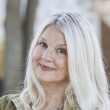How do I explain who I am without explaining who I was? LaVelle Olexa pondered this question when she left her job in 2009. She was used to being a Somebody, one of America’s most influential fashion executives. Her impressive title — senior vice president and fashion director at Lord & Taylor — assured her front-row seats at top designer shows and a role in shaping style trends for more than 20 years. Then the retail business shrank, and Olexa was forced from one stylish life chapter into a new, unscripted one. Even though she had known what to wear since she started her fashion career as a model for Neiman Marcus, knowing what to say proved trickier when she became a former fashion director.
Who would she be without her title? Sure enough, a few days after her exit from Lord & Taylor, Olexa went to a cocktail party, and a woman asked her that perennial icebreaker: “What do you do?”
“I’m standing there, choking, and telling myself, ‘You said you wouldn’t do it … you said you wouldn’t start this sentence with ‘I was …’ ” Olexa recalled. She went home that night and wondered: What am I going to do? I can’t identify with Lord & Taylor anymore. I have to define myself.
Tip No. 1 for defining yourself: Get a business card
Olexa had a card made with just her name, her phone number and her email address. She decided: “My name is going to have to be enough.” After all, she still owned every creative tool in her arsenal and every bit of hard-earned experience. She still knew every friend, designer and connection cultivated during a brilliant career. That first tiny step, that small piece of paper, helped her get over a psychological hump. Her business card reminded her: Title or no title, she’s a Somebody.
Remember: Your “do” is not your “be”
“What we do is not our identity,” says Florida psychotherapist Connie Ingram. “We do what we do because of who we are — but our jobs are simply our professions. Somewhere in the process of working in our chosen fields, we turn what we do into who we are.” And why do we do that? Because the question “what do you do?” is really about hierarchy — it is small talk used to determine where we “rank” with another person. “When we ask, ‘What do you do?’ we are really asking, ‘Where will I fit into this relationship?’ ” Ingram says. When we base our personal value on what we do, we are judging ourselves on our “do” instead of our “be” — and that’s the wrong scale.
Her advice: Value people over professions
This also goes for women who find themselves adrift when their adult children leave home. For moms, it’s called the empty nest syndrome. For career women, let’s call it the empty desk syndrome. Or the empty in-box syndrome. What? You get nervous when you don’t have 100 colleagues demanding your attention and making you feel needed? Put your hyperproductivity on pause, turn your time to lifting up people and sharing your knowledge — and see where your “be” belongs now. Olexa launched LaVelle & Co., a mentoring group that connects young businesswomen with experienced women in professions from retail to law to the arts. Today, 200 women have bonded over wine and wisdom at LaVelle & Co. gatherings.
Carol Hochman, the former CEO of Danskin, is one of Olexa’s good friends. Hochman left the corporate world around the same time Olexa did — and she, too, pivoted to mentoring. “When you’ve worked all your life, you think, What do I do next?” Hochman says.
Her tip: This is just another chapter of life. Prepare for it
The word “retirement” is simply not right for how she looks at this time in her life, Hochman says. “We’re still young and healthy. We can do other things, and we can do them on our time. Plus, we have gravitas.” Gravitas, yes. Women like Hochman and Olexa know what they’re doing. If you foresee a new chapter, Hochman suggests asking yourself what you like best about your job, and figuring out how you can maximize the good parts. Hochman decided not to take another full-time gig, so she and her husband can travel three months of the year. And, like Olexa, she knew her happiness required a connection with other women, particularly younger women. She and a handful of CEO friends launched W.O.M.E.N. in America (that’s Women Optimizing Mentoring, Education, Networking). So far, 200 mid-career women have gone through its 18-month program, and it’s still going strong.
Stay curious. Stay present
Hanging on to any identity provided by a job is risky. So is finding fulfillment in an overloaded in-box. Sure, it’s hard to ease into new territory when you’ve been the sheriff of the last one, but “curiosity is key,” Olexa says. And so is resilience. She flashes back to her first chapter in fashion, her first major runway show as a model. “It was a huge show and a big deal to me,” she recalls. “As I was walking the runway, I saw the spotlight shine on a beautiful woman in the back of the room. The look of longing on her face burned into my soul.” Olexa’s big runway debut was the first show that beautiful woman with the longing look, a former model, was not doing. That chapter was over for her — and not by her choice. Olexa learned a lesson that day in moving on that she has followed all of her life. “I decided then to never look back,” she says. “Don’t try to grab that spotlight back. Move into a new light.”

Alexander Glandien



